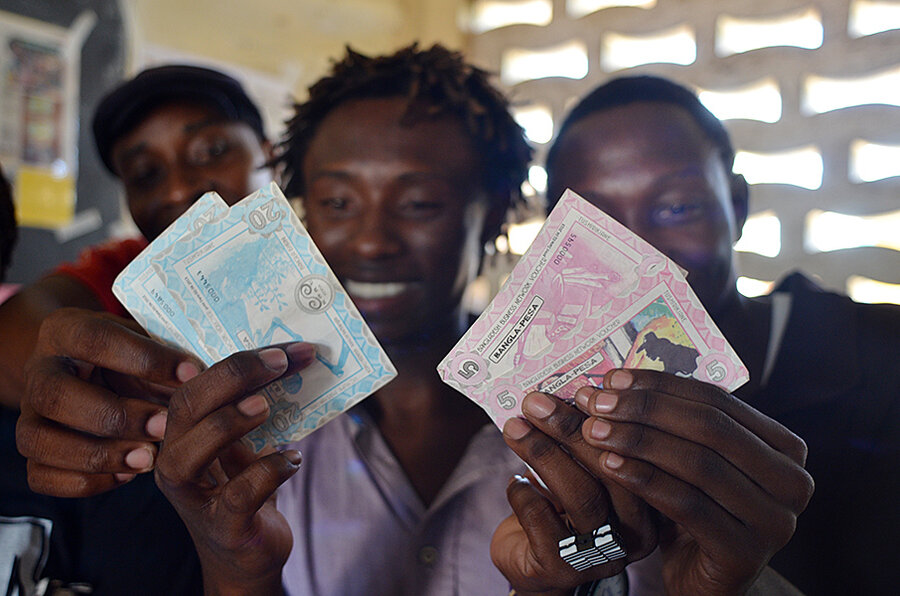In Mombasa, Africa's first 'alternative currency' helps Kenyans fight poverty
Loading...
| Mombasa, Kenya
How can people in the world’s poorest slums increase their businesses – even when they don’t have enough money to buy food every day?
One solution found by residents in a slum on Kenya’s coast is simply to print their own money.
For a year now, more than 180 local businesses in what is called the "Bangladesh" slum near the coastal Kenyan city of Mombasa have used their own colorful currency alongside the Kenya shilling.
It is called "Bangla-Pesa." It is slightly larger than a dollar, comes in 5s, 10s, and 20s, and is helping to stimulate trade in one of Kenya’s most neglected places by its use in businesses, churches, and schools.
The slum, home to 20,000 people who live with no paved roads, running water, or electricity, is 100 percent native Kenyan. It is nicknamed "Bangladesh" since locals say the place is as poor and congested as the South Asian nation. "Pesa" is Swahili for money.
Bangla-Pesa works by allowing barter between small business owners. Since Bangla-Pesa is accepted only in "Bangladesh," the cash stays in the community, allowing people to save their Kenyan shillings for bigger purchases.
For example, a motorcycle taxi driver may have the capacity for 20 trips a day but only takes five. At the same time, a fish vendor throws out 20 percent of her stock. With Bangla-Pesa, the fish vendor can buy a ride to the market instead of walking; the taxi driver can buy the excess fish, or something else.
The Bangla-Pesa acts as a voucher for the trade.
“The whole idea of alternative currencies is to help communities manage themselves with local economies and local leadership,” says Will Ruddick, an American economist living in Kenya who introduced the Bangla-Pesa last May, sparking a large outcry from Kenya's central bank that he was undermining the shilling.
After government charges and a brief arrest, Mr. Ruddick went free as he explained that Bangla-Pesa allows people to tap into excess goods and services that already exist in their community, but that go to waste because residents don’t have enough capital to buy them.
“Cities and local markets are the real unit of the economy," he says. "The question is how much excess do all these businesses have? How much more business could they do if they had more access to trade credit?”
The use of alternative currencies isn't new. But they have become trendy due to the success of Bitcoin, a popular but expensive digital currency. Switzerland's WIR Bank, for example, has put out its own currency, the WIR-franc, for 80 years -- and it is used by more than 60,000 Swiss businesses.
Other alternative currencies are found in various degrees of use in Brazil, on US Indian Reservations, and elsewhere.
What's different about the Bangla-Pesa is that it is Africa's first alternative currency and is designed to fight poverty and is apparently having a good effect.
After a year of use, there is both actual and anecdotal evidence that the new currency is helping people's lives.
Alfred Sigo sells flour, soap, and other basic goods at a small makeshift shop. He makes 400-500 Kenya shillings ($4.60 to $5.70) per day, plus the equivalent of 70 more (about 80 cents) in Bangla-Pesa. With his mother and his younger sisters to support, any extra business helps.
“If you have 10 customers with the Kenya shilling, you can get two more with the Bangla-Pesa,” he says. The extra Bangla-Pesa he uses to buy vegetables, and the extra savings in Kenyan shillings pay his sisters’ school fees.
“Bangla-Pesa complements the work of the Kenya shilling,” Mr. Sigo says. “When you don’t have enough, it’s the extra coin.”
Ruddick's data finds that Bangla-Pesa users come out ahead by an average of 84 shillings a day, equivalent to 98 cents. That sounds like a tiny increase, but for people living on a few dollars a day, it represents 16 percent more spending power.
“For some people, that’s feeding their kids,” Ruddick says.
Helpful in tough times
The currency also appears to be used the most when times are tough. Top usage came after school fees were due, and in January after the holidays, when average profits fall to 200 shillings ($2.30 a day).
“In bad times some people are operating 100 percent Bangla-Pesa,” Ruddick says. “There’s one woman in Bangladesh who sells [a fermented porridge called] uji. Bangla-Pesa basically sustains her.”
Even churches and schools accept Bangla-Pesa for donations and tuition, and in turn spend the Bangla-Pesa locally on lunches for worshipers and students.
Establishments that use the Bangla-Pesa place a large sticker on their metal shacks or wooden stalls after joining a formal network. Each gets 400 shillings worth of notes, though 200 is handed back to the network in a kind of tax to fund things like trash collections and health services.
“You got your own informal economy, your own currency, doing your own taxes for your own services,” says Ruddick. “That’s a huge burden off the government.”
At a community meeting attended by 50 business people in Nairobi’s Kawangware slum this week, locals heard from Ruddick about alternative currencies. Francis Wanjala, a resident who organized the meeting, hopes that working together will foster cohesion in a socially and ethnically diverse slum.
“There’s a lot of mistrust when people look at each other as competition,” he says. “But with a business community you see your neighbor buys from you, and you also buy from him. It complements.”





